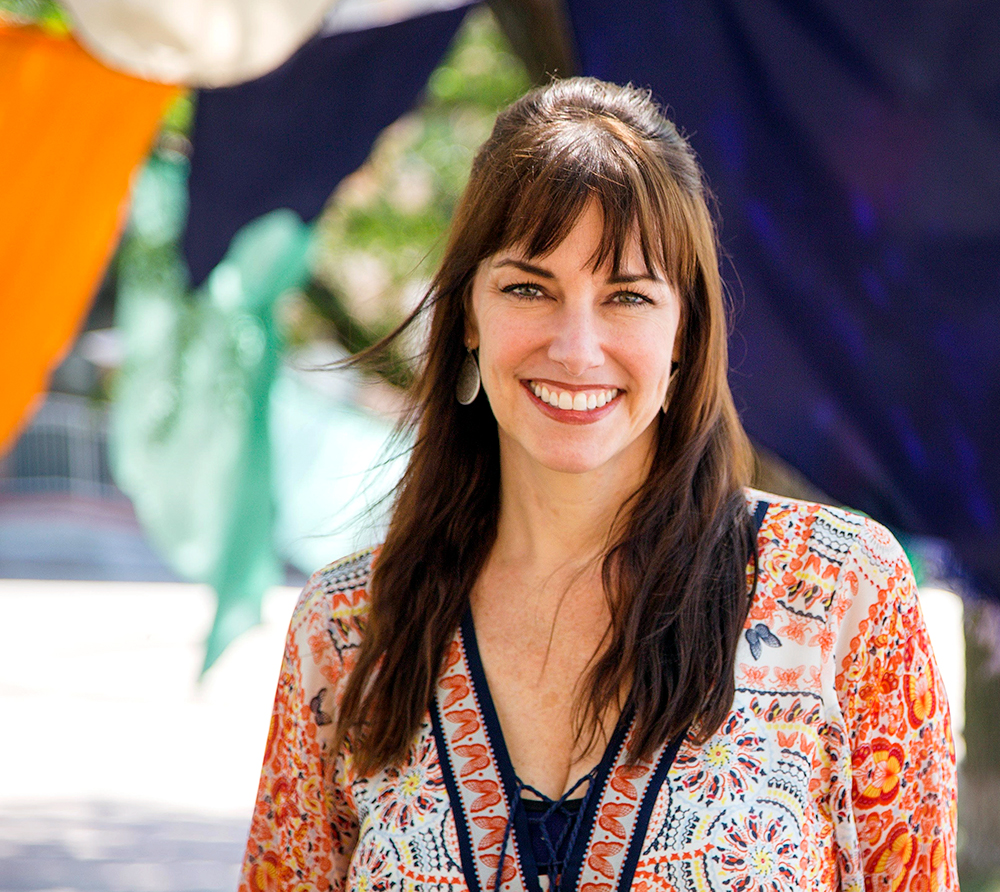
Few artists in our music community have a resume like Erin McGrane’s. An actress, singer, songwriter, and musician, she has been a member of several heralded live-music ensembles, including Alacartoona. Most notably, her acting history includes a very conspicuous supporting role in the 2009 Oscar-nominated film Up In the Air, starring George Clooney.
These days, McGrane is steeped in several arts- and music-related projects, including Victor & Penny, which she started more than ten years ago with her now-husband, guitar virtuoso Jeff Freling.
She recently answered questions from In Kansas City about her illustrious career in her adopted hometown and about what lies ahead for her and Victor and Penny.
Your history in the Kansas City music community goes back decades. What are your earliest memories of being a musician/performer in Kansas City?
I came to Kansas City in the late 1980s to finish my undergraduate degree in theater-performance at UMKC. I spent my first years focused on theater, performing as an undergrad in academic work. My first professional role in Kansas City was in the chorus of Rocky Horror Picture Show at the Unicorn Theatre.
A friend at UMKC introduced me to Eric George, a musician/artist who was in a band, the Psychowelders, and one of the three founders of the arthouse collective, The Human Observation Lab (H.O.L.). I joke that everyone I know today I met through Eric George. Near the end of my college days, I was cast as the lead in a new rock musical, Plan 9 From Outer Space, and Eric was the band leader. It was through my relationship with Eric and exposure to his circle that I moved from the theater to the rock club.
I formed a band with some of my friends—Blue Museum—which featured Betse Ellis on electric violin and me on flute and vocals. Blue Museum played about 250 shows, recorded three albums, and made music together from 1990-98.
My first appearance on a rock stage in Kansas City was sitting in with The Gin Bankers at Davey’s Uptown. The Bankers played Because I Do by X, and I sang Exene’s part. I was hopelessly hooked on rock and roll.
How did those days shape and inform you as a performer? Who were some of the people who influenced you most?
Coming from a rural town in northwest Iowa, I thought these artists were bold and fearless; their ideas were different than anything I had been exposed to. I soaked up every word, every experience. I was thirsty for the chance to explore ideas and create generative work. I threw myself into it, watching and learning from them. Through these experiences I realized my artistic heart lay in generative, performative work centered around music, rather than the more formal interpretive work of theater.
Eric George was undeniably the biggest influence on me artistically. Eric, Leo Wetherill, and Alex Shepherd, the founders of the H.O.L., broke my understanding of performance, music, and art wide open. Anne Winter inspired me to learn more and speak out about injustice through music. Rhonda Francis, the lead singer and lyricist for Psycholwelders, shaped my understanding of the role of women in music and how to use the pen to say more through your lyrics.
The popular KC rock bands that were writing their own music and performing it at a high level changed what I thought was possible. Mongol Beach Party was my favorite, but I was inspired by Sin City Disciples, Season to Risk, B.C.R. There were so many great bands that were totally unique. Theresa from Pamper the Madman and the musicians of Frogpond broke barriers. And then there were the performance artists that came from theater and used their art to raise awareness of injustice. I was a board member of the Coalition Against Censorship, along with Anne Winter and Mark Manning, both of whom had a huge influence on me and challenged me to get out of my comfort zone for the sake of others. Scott Cordes and Lisa Cordes of Eyes Wide Open used performance art to challenge us all to do more.
Alacartoona was a genuine ground-breaking force in our music world: equally strong parts of song, musicianship, theater. What do you think of when you recall that troupe?
Alacartoona remains my favorite, most challenging, and most satisfying project. It was the perfect amalgam of art, theater, music, and daring. In Alacartoona, I was able to create a character within a world that we imagined. We wrote songs, one-act plays, poems, and performance art that explored facets of these characters and of their flawed human emotions. We were thrilled that so many fans walked through Alacartoona’s doors and into our world. I miss it, honestly. Our last show was December 2012, but even now, not a week goes by that someone doesn’t mention Ruby Falls or Alacartoona to me.
In my streaming service Up In The Air is on pretty regularly. If you see it’s on, do you watch it? What is your perspective on that experience—being part of a popular and well-received movie?
I generally don’t like to watch myself perform. However, I have watched my scene in Up in the Air many times. It was such a great experience top to bottom and I’m proud of my work in the scene. The scene is short but contains a lot of emotional information to convey. I remember something I was taught as an undergraduate actor: there are no small parts.
It was exciting. What can I say? It will be a highlight of my life. George Clooney was wonderful, and we stayed in contact for a time after the movie. It was thrilling to watch the Oscars on TV—it was nominated for six that year. I was nervous on set, but I was also ready. I’m proud of the movie and of my work.
I remember talking with you and Jeff when you’d decided to make Victor & Penny a full-time pursuit. How does where you are now with this, a decade later, compare with what you hoped or expected it could be?
We’re in a really good place with Victor & Penny. We’ve accomplished a lot of the things we set out to do. The last ten years didn’t happen the way we thought it would, but isn’t that life? Some of the goals that we set ten years ago we have achieved, and some don’t seem important anymore. Our priorities have shifted now. We feel satisfied and proud of our work. We both feel ready to stretch again, to change, to reinvent and move toward the next adventure. We’ll always return to Victor & Penny; we love it, and it still brings so much joy. Playing music and creating art with Jeff is one of the best things in my life. But we don’t feel the need to perform 150-200 days on the road a year right now.
There are several couples in this town who are in music projects together. I’m thinking of you and Jeff, Betse and Clarke, Shapiro Brothers (and feel welcome to mention any others).
Talk about what being involved in such an intensely creative project requires from two people who are also committed to the relationship outside the music.
Working together, creating art together, and making a life together can be overwhelming. I believe it works for us because we were older when we started. We knew who we were and what we needed. Now, we give each other lots and lots of space, and we’re each other’s greatest fans. We have separate rooms/studios/offices in which we work. We have enormous patience with each other, and we have been through so much, nothing fazes us. Supporting each other’s work, listening, giving honest critical feedback: All those things are necessary.
How have things changed for women in the worlds of music, theater, and the arts in general? Do you still encounter people and moments where it feels like progress has been stunted or things have regressed?
I think entertainment is still a male-dominated field. It’s changing, but it will take more time. It’s better than it used to be, and the #metoo movement has helped us call out some of the wrongs inherent in the system. There is a feeling of solidarity rather than competition among the women artists. I know that I find it encouraging and exciting. The young women coming up today are bold and smart, and they have more resources and knowledge of the world than we did. I can’t wait to see the mark they make on the world.
The ukulele: You have become a genuine, established player and a teacher, one who started her own academy. Express your love for the instrument. Do you still play your father’s ukulele?
I still play my father’s 1951 Hofner ukulele. I have searched for years for a replacement so that I don’t have to take it on the road, but nothing else sounds like it. Its unique tone is crucial to our V&P sound. And I still love it. It’s my most prized possession. When he gifted it to me, my life changed.
In terms of the way I play, or my style, I followed what felt right and most natural to me. From the beginning, I knew I wasn’t interested in being a soloist—and Jeff is so gifted there was no need for me to be. What I felt drawn to was the challenge of playing rhythm. I love that rhythm role is often played by men on drums, bass, and piano. Could I do it on ukulele?
I liked turning the whole thing on its head: the small instrument known for light strumming and singing holding down the bottom, and the big jazz guitar known for comping and chording, soaring over the top of the music.
And how many rhythm ukulele players are there? I wanted to be different, energetic and exciting, like rock and roll for the uke, but rooted in the guitar-duo tradition. My style formed from all the influences in the years before: rock and roll, theater, performance. I’m largely self-taught on ukulele and it is my fourth instrument, so I went with my heart and I learned fast.
What’s in store for Victor & Penny?
I hope to play more live shows with our band. We’d like to do targeted touring as we have been for the last few years. More conferences where we present and teach for organizations such as Folk Alliance International and South by Southwest.
The Wonderstruck Ukulele Academy we co-founded with our business partner and friend, Danielle Anderson, is a joy every year. It has ukulele in the title, but the immersive weekend we hold in Colorado is focused on creativity, songwriting, and performance, not just ukulele. We have been mentoring younger artists and we want to do more of that.
Giving back to our creative community, especially here in Kansas City, is important to us now. We recently raised $20,000 via an online concert for the Midwest Music Foundation to provide cash grants to artists impacted by the pandemic. We see that we can use the V&P platform to raise awareness and bring people together.
You are a director and board member of the Heartland Song Network. Explain your role and the role of the project. What will it provide that has been missing from our community?
Heartland Song Network was created by Danny Powell and Diana Ennis to provide resources and support for generative musicians in the Midwest region. Those resources encompass financial, networking, educational, structural, industry expertise and more. We had just begun work when the pandemic struck, and we decided to partner with Victor & Penny to raise money for the local musicians. Our ability to pivot quickly gave us a solid launch. Since then, we are full steam ahead, providing access to industry professionals we don’t have here, like music supervisors, large booking agencies, etc. through online webinars.
What are you working on now? What excites you?
I’m interested in continuing my exploration of the intersection of music and theater. I’m working on a new performance, tentatively called Sounds Like A Feeling, which incorporates spoken word, movement, visuals, and musical sound-scaping. Jeff will be the composer and I am writing the text. We debuted several pieces from this work on a live stream for InterUrban Arthouse in April. I haven’t been this excited about a new work in a long time. I hope to see it produced live on stage this fall or winter, depending on the state of the world.
I’m also working on a new body of material that is mainly poetry and essays, perhaps a memoir. I’ve been quietly writing for the last couple of years and am just now beginning to bring some of it out into the public. I’m writing a series of essays about growing up in rural Iowa, it’s funny and dark and (mostly) true.
I’m editing a large body of poetry and prose about anxiety that I’m very excited about. It’s funny and dark and (mostly) true. I’m returning to work I started a couple of years ago that sprang from the #metoo movement and it’s dark and definitely true.
I feel excited and called to write these stories and I’m working weekly with former Kansas poet laureate Caryn Mirran-Goldberg as my editor and writing coach. We’ll see where this all leads, but I’m very excited to bring this new work out into the light.
Like many artists in our arts/music/entertainment community, you could live and work anywhere if you chose. Why Kansas City?
When I worked in Chicago for six years, people from Kansas CIty would ask what I was working on in Chicago—something artistic, they meant. I said that it was in Kansas City that I always did my best, most creative work. Chicago was for making money; Kansas City was for making art.
Kansas City is home. Kansas City’s heart is huge. The breadth of talent and the willingness to work together is real. We’re survivors and dark horses. We’re the flyover come-from-behind-ers. We’re the get-it-done-ers and the living hopers. We have each other’s back and we’re looking forward together.
Want more Timothy Finn?
Check out his weekly online-only content, including his Top 5 Not-to-Miss Concerts in the metro and his revered, rollicking, reasoned reviews and commentary.
Email Timothy Finn at tfinn@inkansascity.com


